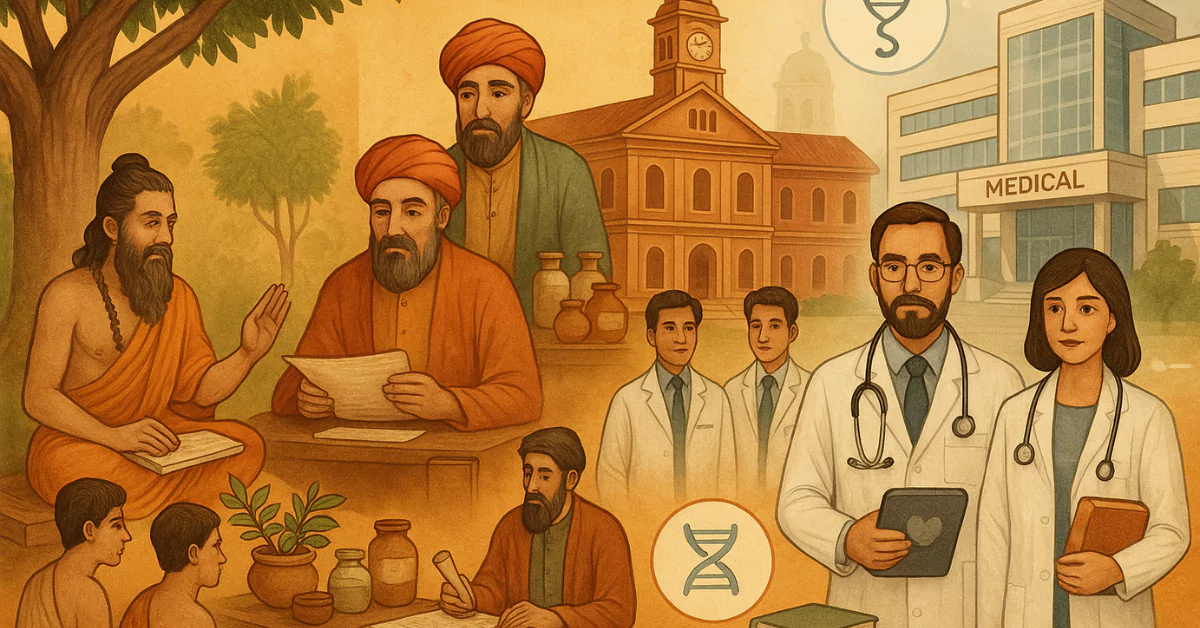History of Medical Education in India: Medical education in India has a very long and rich history, blending traditional knowledge with modern scientific advancements. From the Vedic age to the establishment of AIIMS and the recent reforms under the National Medical Commission (NMC), the journey reflects India’s continuous effort to create a robust healthcare education system.
What is in the Article
Ancient History of Medical Education in India
The history of medical education in India is among the richest in the world, tracing its origins back to the Vedic period and evolving into structured systems like Ayurveda. Long before modern medical colleges, India developed the spiritual philosophy, practical surgery, pharmacology, and holistic healthcare practices that influenced global medicine.
Vedic Period (1500 BCE – 600 BCE): The Spiritual Roots of Medicine
- In the Vedic age, medicine was not seen as separate from religion or philosophy.
- The Atharva Veda, often regarded as the first medical text of India, contains numerous references to:
- Healing rituals
- Herbal remedies
- Mantras for diseases
- Diseases were believed to have both physical and spiritual causes, requiring treatment that combined natural medicines with prayers and rituals.
- Early healers, known as Vaidyas, played the role of both physicians and spiritual guides.
This early integration of body, mind, and spirit laid the foundation for holistic medicine in India.
Ayurveda: The World’s Oldest Medical System
By the 6th century BCE, Indian medicine had taken a more systematic form under Ayurveda, which means “science of life.”
Key Texts of Ayurveda
Charaka Samhita: Focused on internal medicine, physiology, and understanding the balance of the three doshas (Vata, Pitta, Kapha).
Sushruta Samhita: Considered the earliest known text on surgery, describing:
- Rhinoplasty (plastic surgery of the nose)
- Cataract surgery
- Lithotomy (removal of bladder stones)
- Suturing techniques and surgical instruments
Ashtanga Hridaya: A comprehensive consolidation of Ayurvedic knowledge that became a standard reference for students and practitioners.
“These texts reflect a highly advanced knowledge of anatomy, diagnosis, and treatment, centuries before modern medicine.“
Ancient Indian Physicians and Their Contributions
| Physician | Period | Key Contributions |
|---|---|---|
| Sushruta | 7th-6th century BCE | Authored Charaka Samhita (fundamental Ayurvedic text); emphasised preventive & curative healthcare; explained three doshas (Vata, Pitta, Kapha); detailed human physiology and foetal development. |
| Acharya Charaka | 150-200 CE | Authored Charaka Samhita (fundamental Ayurvedic text); emphasised preventive & curative healthcare; explained three doshas (Vata, Pitta, Kapha); detailed human physiology and foetal development. |
| Jivaka | 6th century BCE | Personal physician to Lord Buddha & Sangha; studied under Atreya; advanced natural wound treatments & purgatives; contributions recorded in Bower Manuscript, Dipavamsa, Mahavamsa. |
| Nagarjuna | 78 CE | Expert in alchemy & chemical medicine; studied mercury-based therapies; described circulatory system (rakta dhatu); authored Rasa Ratnakar & Vigraha Vyavar Vartika; redacted Sushruta Samhita. |
| Vagabhata I | 6th century CE | Authored Ashtanga Samgraha (medicine, surgery, anatomy, hygiene); emphasised personal hygiene & pollution control (effects of impure river water). |
Centres of Learning: Gurukuls and Universities
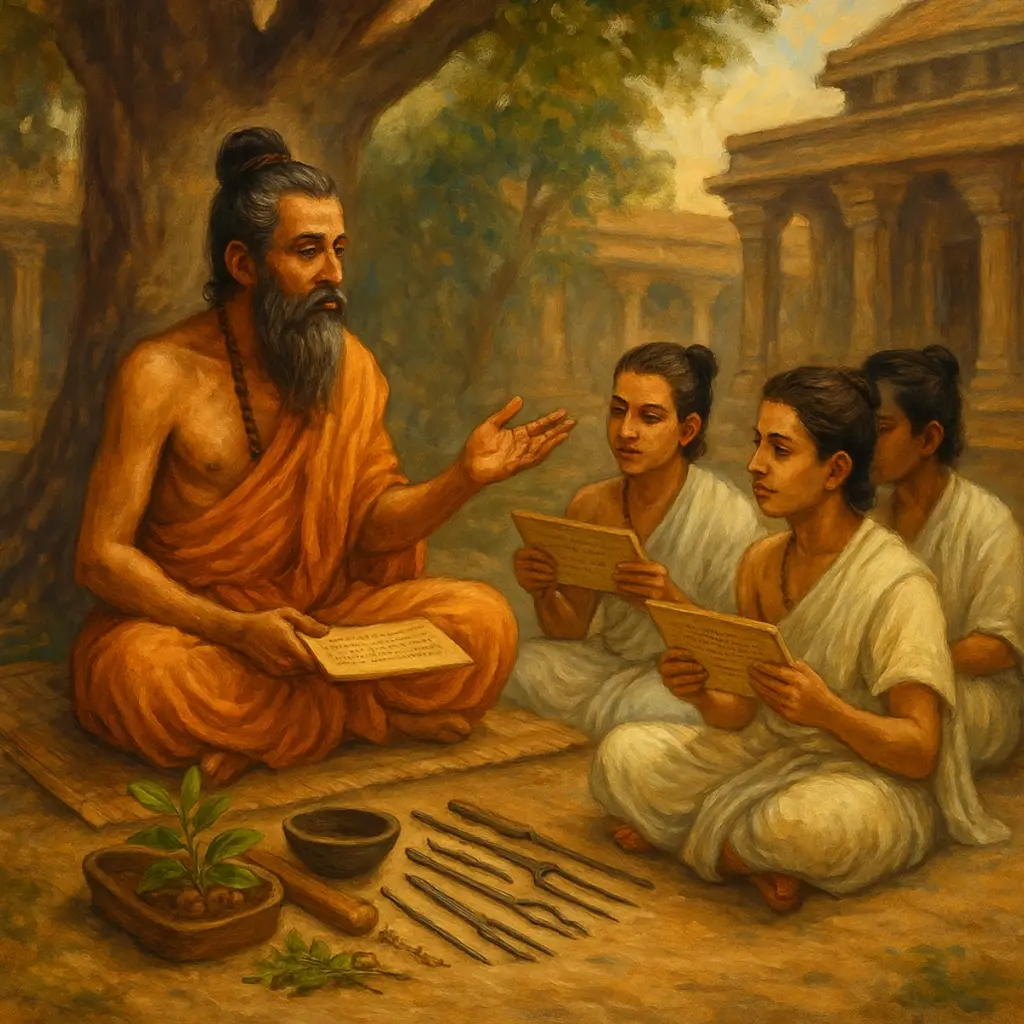
Medical education during ancient times was not confined to texts alone but was taught in structured institutions.
- Gurukuls: Students lived with their teachers (Gurus) and learned medicine as part of an integrated system combining philosophy, surgery, and herbal pharmacology.
- Takshashila University (5th century BCE): One of the earliest global learning hubs, where students from across Asia studied medicine, astronomy, and philosophy.
- Nalanda University (5th-12th century CE): Famous for its library and medical school that attracted scholars from China, Korea, Tibet, and Central Asia.
“These institutions made India a global hub of medical education, blending theory with practice.”
Global Influence of Ancient Indian Medicine
- The knowledge of Ayurveda and surgery spread to regions like China, Tibet, Greece, and the Middle East.
- Ancient Indian surgical practices influenced the development of Greek and Arab medicine, which later contributed to European medical traditions.
- Today, Ayurveda continues to be recognised as a formal system of medicine in India and is gaining popularity worldwide as a form of alternative and holistic healthcare.
Legacy of Ancient Medical Education
The ancient Indian model of medical education set benchmarks that remain relevant:
- Community orientation: medicine as a service to society, not merely a profession.
- Holistic approach: treating the body, mind, and spirit together.
- Integration of theory and practice: detailed anatomical study and real surgical procedures.
- Institutional learning: universities and gurukuls as centers of excellence.
Medieval History of Medical Education in India (9th-18th Century)
The medieval era (8th-18th century) was a significant phase in the evolution of medical education in India. This period witnessed a fusion of indigenous knowledge systems with external influences, especially through the advent of Unani medicine, introduced by Persian and Arab scholars.
Rise of Unani Medicine
- Unani medicine enriched India’s medical heritage by introducing a structured approach based on the theory of four humours (blood, phlegm, yellow bile, and black bile).
- Hakims, or Unani practitioners, became renowned for their diagnostic skills, herbal remedies, and emphasis on lifestyle modification to maintain health.
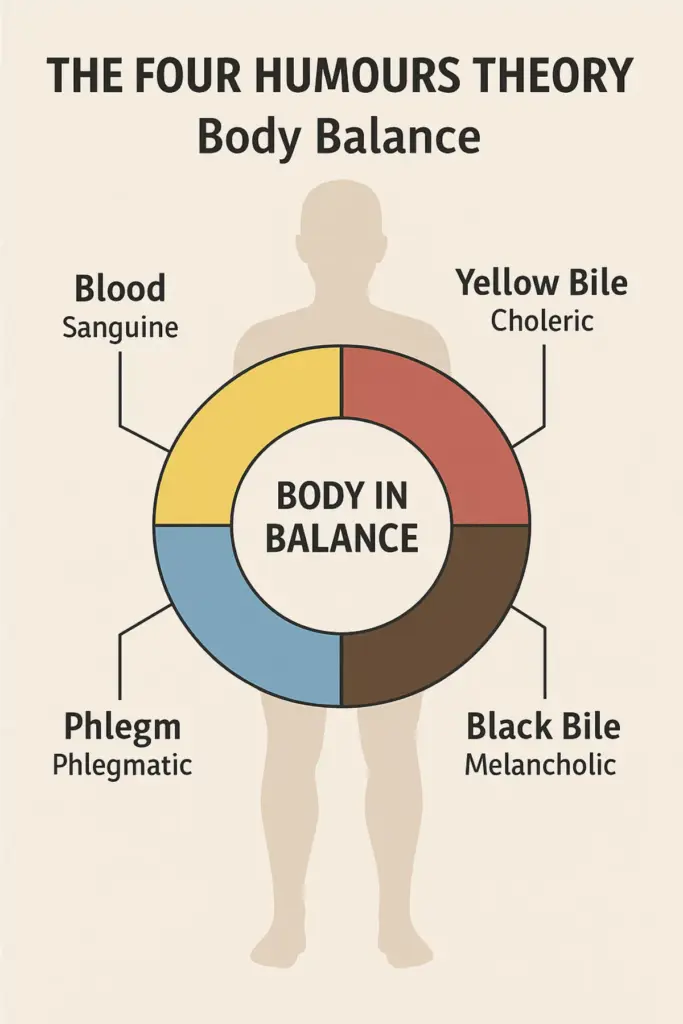
Important Milestones in the Evolution of the Unani System of Medicine
| Year/Period | Event / Contribution |
|---|---|
| 5000 BCE | Papyrus documentation of Egyptian use of medicinal herbs |
| 3000 BCE | Medical literature attributed to Mesopotamian physicians |
| 580-489 BCE | Pythagoras presented the four proximal qualities (hot, cold, wet, dry) and the crisis phases of diseases |
| 460-370 BCE | Hippocrates’ concept of four humors (Akhlaat) and medical ethics |
| 1st Century CE | Dioscorides compiled a 600-page illustrated book De Materia Medica (Kitab al-Hasha’ish) |
| 200 BCE | Organisation of the Greek (Unani) system of medicine by Galen |
| 750-850 CE | Translation of Greek medical texts into Arabic |
| 800 CE | Establishment of Bayt al-Hikma (House of Wisdom) in Baghdad for the translation & collection of medical works |
| 800 CE | Introduction of the Greco-Arab (Unani) system of medicine into India |
| 1200-1857 CE | Development of the Unani Medical System in India during the Sultanate and Mughal periods |
| 1595 CE | Establishment of Dar al-Shifa, the first Unani teaching hospital of Deccan, by Sultan Muhammad Quli Qutub Shah |
| 1906 CE | Establishment of All India Ayurvedic & Unani Tibbi Conference by Hakim Ajmal Khan |
| 1964 CE | Government of India established the Unani Pharmacopoeia Committee |
| 1971 CE | Implementation of the 1970 Indian Medicine Central Council Act and formation of CCIM |
| 1971 CE | Incorporation of Chapter IV-A in the Drugs & Cosmetics Act, 1940, for Ayurveda, Siddha, and Unani regulatory provisions |
| 1978 CE | Establishment of the Central Council for Research in Unani Medicine, New Delhi |
| 1995 CE | Department of Indian Systems of Medicine & Homoeopathy (ISM&H) was established in the Union Ministry of Health & Family Welfare |
| 2005 CE | Mainstreaming of the AYUSH strategy under the National Rural Health Mission (NRHM) |
| 2014 CE | Department of AYUSH upgraded to the Ministry of AYUSH (Ayurveda, Yoga & Naturopathy, Unani, Siddha, Homoeopathy) |
| 2020 CE | The National Commission for Indian System of Medicine (NCISM) was constituted under the NCISM Act, 2020, after the dissolution of CCIM |
Coexistence of Medical Systems
Medieval India was a melting pot of diverse medical traditions:
- Ayurveda continued as a deeply rooted system of medicine.
- Siddha medicine, particularly popular in South India, evolved further.
- Yoga was practised both as therapy and a spiritual discipline.
- Unani gained royal patronage, especially during the Delhi Sultanate and Mughal period.
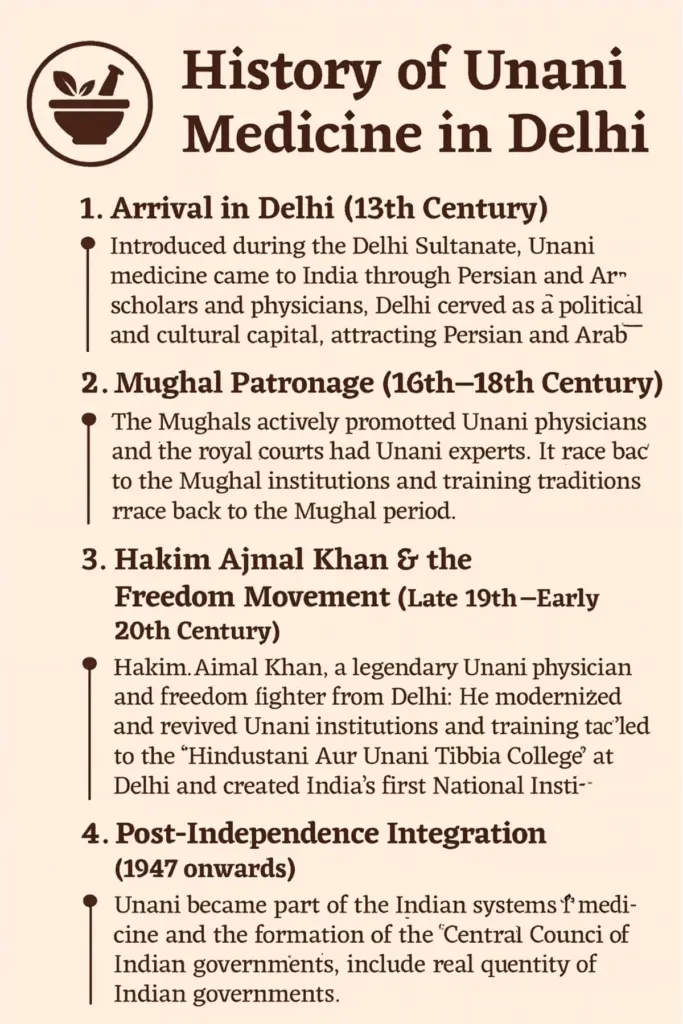
Informal and Guru-Based Learning
- Unlike modern universities, institutionalised medical education was limited.
- Most learning happened through guru-shishya (teacher-disciple) tradition, apprenticeships, and family lineages of practitioners.
- Manuscripts and oral teachings were key sources of medical knowledge transmission.
Legacy of the Medieval Period
- The coexistence of Ayurveda, Siddha, Yoga, and Unani created a rich, pluralistic medical culture in India.
- The integration of Unani practices with local traditions laid the foundation for a diverse medical heritage that continues to influence healthcare in India today.
Modern History of Medical Education in India (18th-20th Century): Colonial Era
Portuguese Contribution to Medical Education in India
Today, Goa Medical College (GMC) traces its legacy back to Portuguese foundations.
First Western Medical School in India (1842)
- The Portuguese established the Escola Médico-Cirúrgica de Goa (Medical-Surgical School of Goa) in 1842, considered the first Western-style medical school in India.
- It was later upgraded to the Goa Medical College (GMC), one of Asia’s oldest medical colleges.
Introduction of Western Medicine
- The Portuguese introduced modern anatomy, surgery, and pharmacology to India at a time when traditional medicine (Ayurveda, Unani) was dominant.
- They set up dissection halls, laboratories, and teaching hospitals for structured training.
Integration of Local Students
- Unlike some colonial models, Portuguese medical institutions allowed Indians to enrol and qualify as doctors.
- This gave rise to some of the first generations of Indian-educated physicians in Western medicine.
Public Health Contributions
- They emphasised public health, sanitation, and tropical medicine, vital for coastal regions dealing with malaria, cholera, and leprosy.
- Hospitals in Goa (like Hospicio Hospital in Margao) played both a clinical and teaching role.
Portuguese Texts & Training
- Medical training was initially in the Portuguese language, with textbooks and curricula imported from Europe.
- Graduates were recognised in Portuguese colonies worldwide, giving them international mobility.
Foundation for Modern Medical Education
- The Goa model later influenced British medical institutions in Calcutta, Madras, and Bombay.

British Contribution to Medical Education in India
Introduction of Modern Medical Education (19th Century)
- The British established the first medical colleges in India to train doctors in Western medicine.
Early institutions included:
- Calcutta Medical College (1835): first modern medical college in Asia.
- Madras Medical College (1835).
- Grant Medical College, Bombay (1845).
Read Also: First MBBS Batch of India (1835): How British Shaped Modern Medical Education
Shift from Indigenous Systems
- The British promoted allopathic medicine over traditional systems (Ayurveda, Unani, Siddha).
- This marked a major shift toward Western scientific training in anatomy, physiology, and surgery.
Development of Curriculum & Examinations
- Standardised curricula, degrees, and examinations were introduced.
- Medical education followed British university models (London, Edinburgh).
- Dissections, laboratory training, and clinical bedside teaching became norms.
Establishment of Teaching Hospitals
- Each medical college was attached to a teaching hospital for clinical training.
- Examples: Calcutta Medical College Hospital, Government General Hospital (Madras).
Opening Access for Indians
- Initially, British institutions admitted Indians only as apprentices or subordinates.
- Later, formal admission allowed Indians to earn recognised medical degrees, creating the first wave of Indian doctors trained in Western medicine.
Public Health and Research
- The British introduced vaccination programs, sanitation drives, and epidemiological studies.
- Institutes like the Pasteur Institute, Kasauli (1900) contributed to tropical medicine and preventive healthcare.
Regulatory Framework
- The Indian Medical Service (IMS) was created to serve colonial needs but also shaped medical education standards.
- By the early 20th century, medical councils and licensing systems were introduced for uniformity.
Legacy
- The British laid the foundation of structured medical education in India.
- Most leading government medical colleges in India today trace their roots to the institutions established in the 19th century.
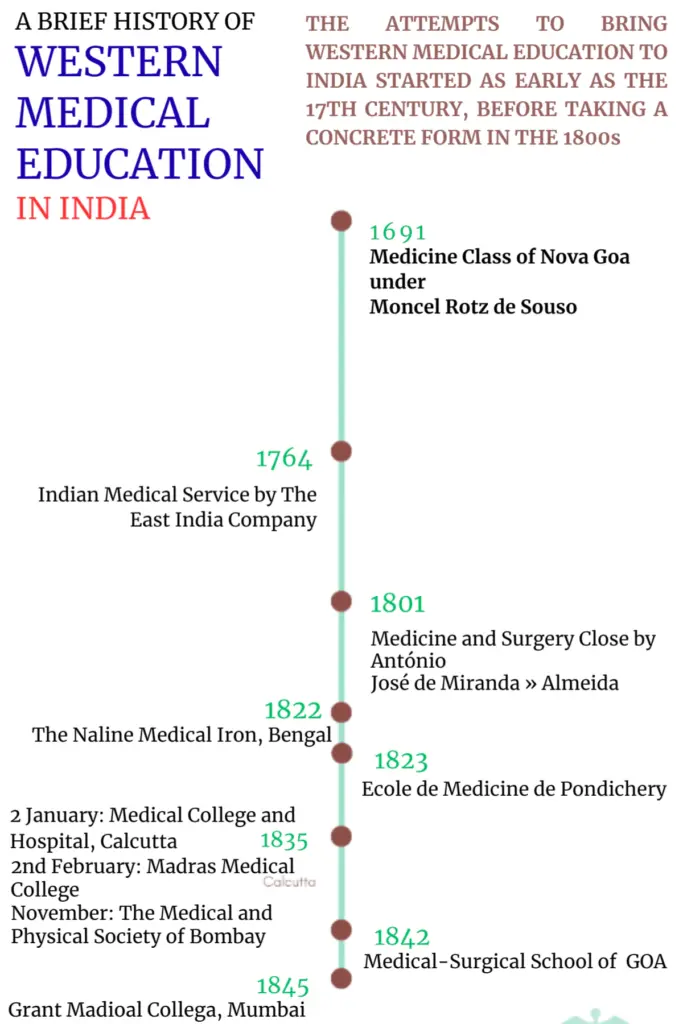
Features of Colonial Medical Education
- Curriculum modelled on British universities.
- Training doctors primarily for the colonial army and administrative needs.
- Public health policies introduced vaccination and sanitation measures.
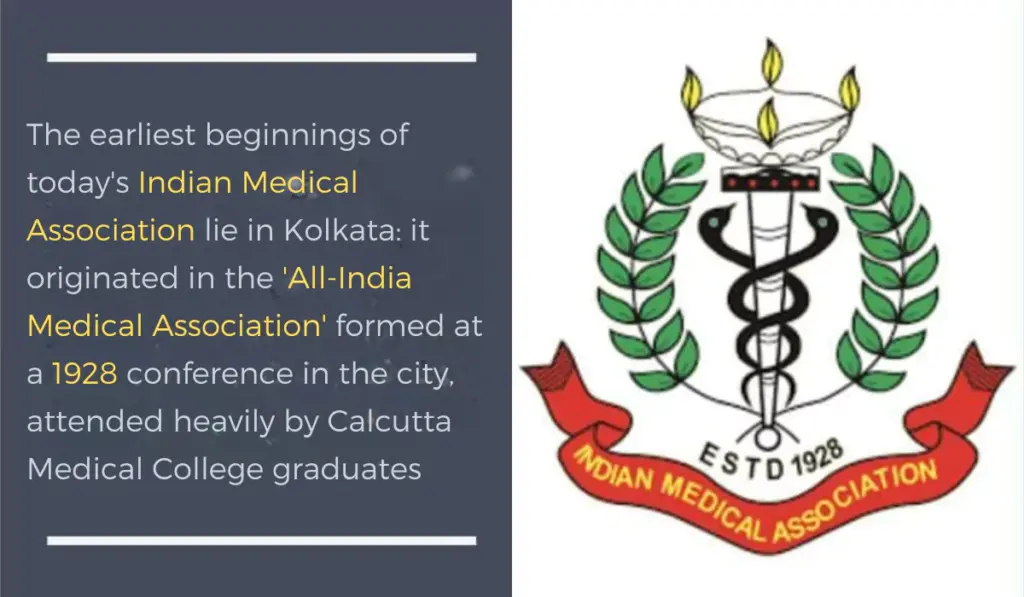
Read Also: Decolonising Medical Education in India: Independence Day 2025
Post-Independence Reforms (1947 – 1980s)
After 1947, India sought to expand medical education to meet national healthcare needs.
- Bhore Committee Report (1946): Recommended integration of preventive and curative medicine, leading to a modern public health framework.
- Establishment of AIIMS, New Delhi (1956): Became India’s premier institute of medical education and research.
- Expansion of state medical colleges to ensure every state had at least one government medical college.
- Growth of postgraduate education (MD/MS) and super-specialty training.
| Bhore Committee Report (1946) The Health Survey and Development Committee, popularly known as the Bhore Committee, was set up by the British Government of India in 1943 under Sir Joseph Bhore to review the health conditions and propose reforms. Its landmark report in 1946 laid the foundation of India’s public health system. |
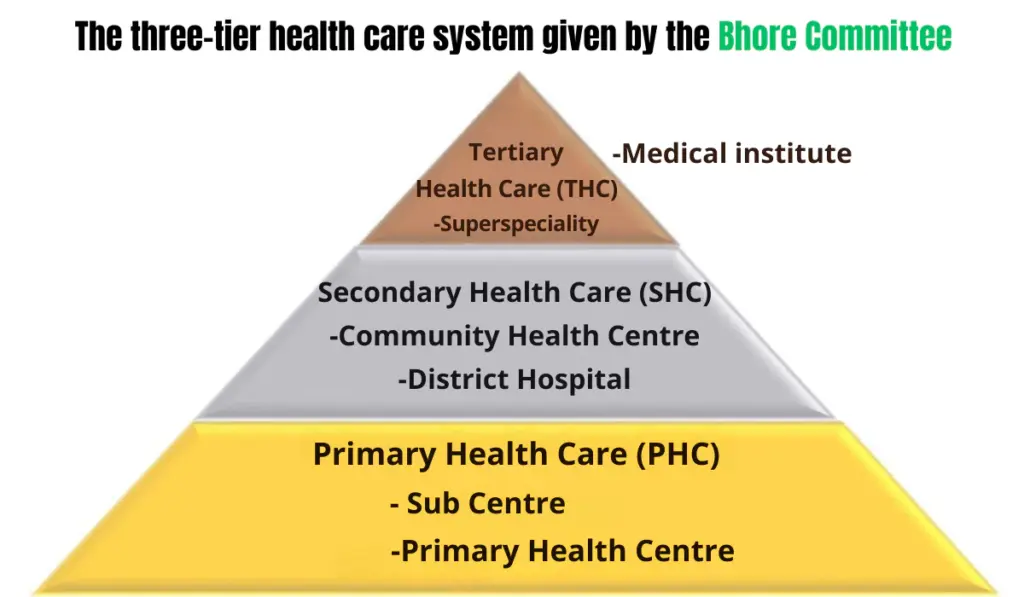
Liberalisation Era and Rise of Private Medical Colleges (1990s – 2010s)
- Economic reforms led to a rapid increase in private medical colleges.
- Demand for doctors and healthcare services created new opportunities, but also concerns about:
- Commercialisation of medical education.
- High tuition fees restrict access to the affluent class.
- Variations in quality between government and private institutions.
- Regulatory oversight by the Medical Council of India (MCI) often came under criticism for corruption and inefficiency.
Read Also: Education and Healthcare Now a Business in India
Recent Reforms and the NMC Era (2019 – Present)
- In 2019, the National Medical Commission (NMC) replaced the MCI to improve transparency and standards.
- Key reforms include:
- NEET (National Eligibility cum Entrance Test): A single entrance exam for MBBS, BDS, and PG courses.
- NEXT (National Exit Test): Proposed as a common licentiate exam for graduates.
- Focus on competency-based medical education (CBME): Introduced in 2019 to make learning outcome-driven.
- Increasing seat capacity: India now has 780+ medical colleges with over 1,18,000 MBBS seats (2025).
Read Also: India’s Medical Education Revolution: NMC Reforms, CBME, NEXT & More
Emerging Trends in 21st Century Medical Education
- Technology Integration: Use of AI, VR, simulation labs, and telemedicine in training.
- Global Exposure: Collaboration with foreign universities and rising trend of Indian students pursuing MBBS abroad.
- Research-Oriented Training: ICMR-STS, student-led research societies, and NIRF-based evaluation of research output.
- Holistic Curriculum: Focus on ethics, communication skills, and community medicine alongside clinical sciences.
Read Also: AI & Modern Technology in Indian Medical Education
The history of medical education in India reflects a journey from ancient Ayurvedic wisdom to modern evidence-based practice, shaped by colonial influences, post-independence reforms, and 21st-century globalisation.
Today, India is one of the largest producers of doctors in the world. Yet, challenges remain—ensuring equitable access, improving quality across private and government institutions, and aligning education with India’s healthcare needs. The future of Indian medical education lies in striking a balance between quantity, quality, and compassion.

